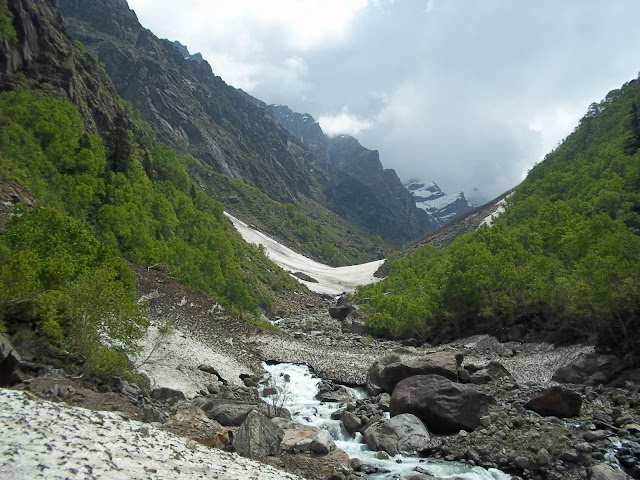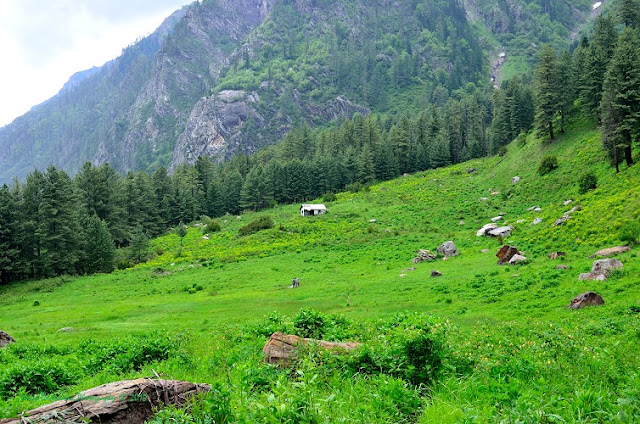Falling in love with the mountains: GHNP
This post carries a piece published in Deccan Herald on 6th June, 2017 - In the lap of nature, high on the mountains.
Thanks are due to Sanju (and colleagues)
for being with us throughout and the fun we had. Himalayan Ecotourism, Stephan Marchal
and Sanjeeva Pandey helped with planning. Arpan forms the other half of the ‘we’
here.
All images in this post including that
on the Deccan Herald website are taking during the trek by Nirlep Dhutwalia. A warm
thank you for sharing your experiences then and images later.
The article on Deccan Herald here. Unedited text placed below.
With the bus engine roaring our second trip,
within 12 months, to trek in the Great Himalayan National Park (GHNP), had just begun. People fall in
love with other people - we had trekked up and down its mountains to fall in
love with GHNP. I sat
besides the large window, staring out into the roads which looked unreal –
quiet, empty and lights falling on them - as 9th June met the 10th.
Late morning, after a long tunnel, we dropped off at Autt.
Image: Nirlep Dhutwalia
From
Autt we went to Sainj by bus and then to Shangarh by a shared vehicle. Here we
stayed at a Home Stay next to the famous meadows. They shared of how caste
played a role in access to places in the village. Of caste and access we would
be reminded of more than once during the week long trek. During night we kept
the door open to get familiar with the chill! Sometime that evening my heart
won over my mind; I would stay away from making detailed notes during the week
and just be there. We were moving with minimal planning and without cameras,
using public transport and trying to soak in the moment.
Walk
began the next day Neuli, Niharni and then up – inside GHNP; a recent entrant
to the list of World Heritage Sites. The Park has had a long journey, dotted
with turmoil and success stories, one that conservation enthusiasts could learn
a lot from. A journey where the first notification for the Park was issued
during 1984 and the first management plan put in place during 1987. Our first
day was easy and a pair of Chestnut-bellied Rock Thrush greeted us as we began
our walk downhill. At the camp-site we got a taste of the food for the trip –
local. We had requested and re-requested the team for local food as opposed to noodles
and their ilk. The menu would only get better as we moved. Of course, this
would have meant the team put in far more efforts to carry and cook. Our
familiarity (and friendship) with the
team was on account of a trek previous
year; during a different season along another route. Team is the
Cooperative which runs the Ecotourism venture and Himalayan Ecotourism which helps
with marketing.
Image: Nirlep Dhutwalia
Up
towards Maror we crossed Shakti and saw Russet Sparrows frolicking on rooftops.
We came across forest department built campuses in the middle of the proverbial
‘nowhere’. GHNP has almost no motorable roads but an extensive network of trekking
route and huts. Also horses and other animals are not allowed to carry luggage.
All this and more part of the conservation design to encourage and promote sustainable
tourism beneficial for the locals! We wondered on the positive difference an
interested and enthusiastic government officer could make! The crux possibly lay
in putting time, moving around the landscape and interacting with the people.
The
next camp-site was in a Thach – meadow - with fresh presence signs of the Himalayan
Brown Bear! Did we want to come across the Himalayan Brown Bear - up close -
all of a sudden outside our tent I asked my colleague! I got up sometime during
the night and looked around! It was stunning. In a few minutes I started
talking, initially with myself and then, as if, with near ones. How would it
feel to sit and talk or soak in silences with them in this pleasant darkness
and hold hands? Holding hands, that most underrated of actions depicting
affection in a physical manner in today’s days of hugs and kisses!
Image: Nirlep Dhutwalia
Here
we saw the snow covering the not very distant mountain tops. Next morning these
salt and pepper tops would turn white, sparkling white of fresh snow. Over tea -
and more tea - we chatted with the team on their ‘interesting’ (read funny) experiences with tourists. One
of them had sought television in their tent for there was not much to do at
night! The discussion then veered to wildlife. When we asked of Snow Leopard we
were told the forest department had not been able to record its presence in
camera traps over the years. The shepherds though tell her tales; tales of the
cat with the thickest of tails. Park’s website says this of its mammals ‘The mammalian fauna of GHNP and its buffer
zone is typical of the several eco-regions of the Western Himalaya. Mammalian
diversity is significantly higher than other areas.’ GHNP was one of the
first Parks, in the country, to get its website and logo.
The
following day we were to go till a lake (Rakhtisar)
but snow and hail did not allow us. It was cold, walking on the snow was not
easy either. Difficult for me, team members – all locals - walked as if they
were in Lodhi Gardens in Lyutens Delhi. Some snow patches were small and others
large enough to cover the river which managed somehow to sneak from below! A
chill ran through the body as I drank the flowing water. Then it rained and the
team set-up fire as it drizzled. Soothing the warmth then felt, though immediately
after the trousers got wet from brushing with the vegetation. Some of these experiences
will turn to endearing memories.
Binoculars
we put to use and saw more than a handful of summer visitors; birds coming up
to escape the heat. These include the Blue-capped Rock Thrush, Scaly Thrush, Dark-sided
Flycatcher and UItra-marine Flycatcher. Redstarts (White-capped, Blue-capped and Blue-fronted) shone in flowing water
and Forktails (Little and Spotted)
played merrily but amidst the birds of their kind Brown Dipper won our hearts.
A resident, it could be one of the more unassuming of birds if one goes by
looks but what it does or keeps on doing redefined pleasure for us. Sitting on
rocks amidst the fast flowing glacial rivers and streams it suddenly dips in
the water and emerges a few feet away before managing to get on the same or
other rock. Such fun it would be to dip and dip again on that running, melting
snow. It eats the insects and vegetation stuck to the stones I was told! The
Park is also recognized as an Important Bird Area
and ‘is particularly noted for its
prolific pheasant populations.’
Image: Nirlep Dhutwalia
Coming
back we took a detour along a longer route – 16 odd kms we trekked that day. The
village Majhan was - to be brief – absolutely stunning. We saw the
Black-and-yellow Grossbeak as we entered the village and the Grey-winged
Blackbird as we left the next morning. By now we were comfortable with our
shoes, bag (size, shape, weight) and
happily managed the walk though we still used to wonder each evening on how the
sun set so late: 7.45 pm. My colleague was keen to figure out route for the trek
next year and got busy. I did what I did most evenings – nothing other than
soaking in the mountain air and stare into the nothingness of the Himalayas.
Route
Shangarh (1,700m) > Neuli (1,400m)
> Niharni (1,500m) > Baha (1,700m)
Shakti (2,100m) > Maror (2,400m)
Parkachi Thach Meadows (2,900m)
Rakhtisar (3,400m) > Parkachi
Maror
Shakti > Majhan (2,000m)
Niharni
I.
Image: Nirlep Dhutwalia





Great stuff, Lovely narration and photographs. We were there on 6th May to 14th May, but we went to Shilt...
ReplyDeleteThanks . . Such a lovely time we had . . Our first trek was on the Shilt route during October and that was equally fun . .
DeleteStill pristine, but for how long?
ReplyDeleteYes . . 850 odd sq kms without roads and absolutely stunning . . hoping it stays long as we need water if nothing else . .
Delete